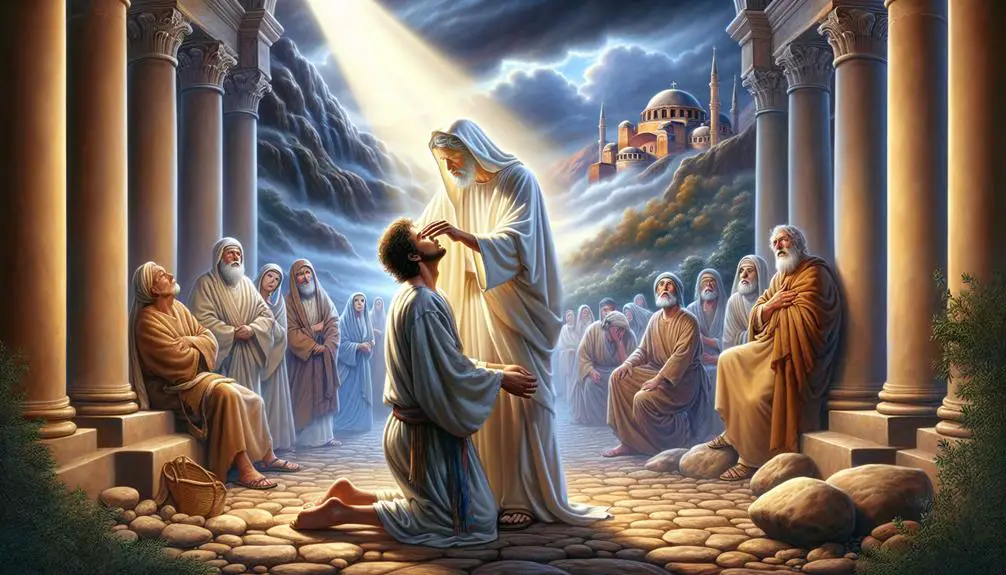A journey through biblical narratives reveals the profound spiritual significance of sight—discover what it truly means to see.

See in the Bible
The concept of sight in the Bible extends far beyond the mere function of vision, intertwining with profound themes of enlightenment, understanding, and divine revelation. From the miracles of sight restoration performed by Jesus to the metaphorical use of light and darkness, the Scriptures offer a rich tapestry of narratives and teachings that illuminate the spiritual dimensions of seeing.
This exploration invites a deeper contemplation of how perception, both physical and spiritual, plays a pivotal role in the biblical narrative. As we consider the implications of visionary experiences and Jesus' teachings on perception, a question arises: how does our own sight align with or diverge from these ancient understandings?
Key Takeaways
- Visionary experiences in the Bible highlight the importance of spiritual perception and divine communication.
- Spiritual blindness is depicted as a barrier to understanding God's wisdom, necessitating faith and prayer for enlightenment.
- Jesus' teachings on perception aim to transform understanding and encourage fair judgment through divine insight.
- Miracles of sight restoration symbolize both physical and spiritual healing, demonstrating divine power and compassion.
The Role of Visionary Experiences

Throughout the biblical narrative, visionary experiences serve as pivotal moments of divine communication, shaping the spiritual and historical trajectories of its characters. These episodes, often encapsulated through prophetic dreams and their subsequent interpretation, underscore a divine mechanism utilized to guide, warn, and inspire. The phenomenon of prophetic dreams, as documented in the scriptures, transcends mere nocturnal imaginings, embedding itself as a cornerstone of theological discourse and understanding.
The interpretative lens applied to these visions is critical, revealing not just the content of the divine message but the profound relationship between the divine and the human interpreters. Vision interpretation acts as a bridge between the ethereal and the tangible, translating abstract spiritual truths into actionable insights. This dynamic is vividly illustrated in the narratives of Joseph and Daniel, where their ability to decode the divine symbolism encapsulated within dreams not only altered their personal destinies but also had lasting impacts on the communities and nations around them.
This interplay between prophetic dreams and their interpretation illuminates a broader theological motif: the accessibility of divine wisdom to those who are receptive. It suggests that divine communication, while mysterious, is not beyond comprehension but requires a discerning heart and mind attuned to the spiritual frequencies of the divine. The biblical portrayal of visionary experiences thus not only enriches our understanding of divine-human interaction but also invites reflection on the nature of revelation, perception, and the quest for spiritual clarity in an often opaque world.
Understanding Spiritual Blindness

In the spiritual journey chronicled within biblical texts, the phenomenon of spiritual blindness emerges as a pivotal barrier to divine understanding and enlightenment. This subtopic aims to explore the multifaceted causes of spiritual blindness, juxtaposing them with strategies for overcoming this profound impediment to spiritual growth.
Causes of Spiritual Blindness
Spiritual blindness, a condition that impedes one's ability to perceive divine truths, often stems from a multitude of complex causes ranging from personal sin to cultural influences. This impairment of spiritual vision can be dissected into various contributing factors, including, but not limited to:
- Prideful ignorance, where individuals choose to elevate their understanding above divine wisdom, thereby obstructing their spiritual sight.
- Cultural influences, which can shape beliefs and attitudes incongruent with spiritual truths, further obscuring one's spiritual perception.
- Personal sin and disobedience, which create a barrier between the individual and divine enlightenment, resulting in a dimming of spiritual awareness.
Understanding these causes is pivotal for addressing the issue of spiritual blindness, guiding individuals back towards a path of spiritual illumination and clarity.
Overcoming Spiritual Blindness
Recognizing and addressing the multifaceted causes of spiritual blindness is essential for embarking on a journey towards spiritual enlightenment. This process involves a deep and analytical exploration into the realms of faith development and the importance of prayer.
Faith development acts as the cornerstone for overcoming spiritual blindness, guiding individuals through the complexities of spiritual awareness and connection. It is through the incremental strengthening of faith that one can begin to peel away the layers of blindness, revealing the clarity of divine truth.
Equally, the importance of prayer cannot be overstated. Prayer serves as the vital communication link between the individual and the divine, a conduit for understanding and illumination. Through dedicated prayer, individuals can seek guidance, wisdom, and the fortitude to overcome the obstacles of spiritual blindness, thus fostering a more profound spiritual connection and enlightenment.
Jesus' Teachings on Perception

Jesus' teachings on perception offer profound insights into the nature of spiritual understanding and the principles of equitable judgment. Through His discourses, He elucidates the necessity of discerning spiritual truths with clarity and the importance of evaluating others with fairness and compassion.
This exploration into Jesus' guidance provides a foundational perspective on the transformative power of perceiving with spiritual acuity and moral integrity.
Understanding Spiritual Truths
Delving into the teachings of Jesus reveals profound insights on the nature and acquisition of spiritual truths, emphasizing the significance of perception in grasping these divine principles. The teachings pivot around the elements of Divine Revelation and Mystical Interpretation, presenting a multifaceted approach to understanding spiritual realities.
- Divine Revelation: Spiritual truths are often unveiled through divine revelation, necessitating an open heart and mind to recognize and assimilate these insights.
- Mystical Interpretation: The parables and teachings of Jesus encourage a mystical interpretation, inviting believers to look beyond the literal to perceive the spiritual significance inherent in His words.
- Personal Transformation: Engaging with these truths is not merely an intellectual exercise but a pathway to personal transformation, guiding individuals towards a deeper, more authentic spiritual life.
Judging Others Rightly
In His teachings on perception, Jesus profoundly addresses the theme of judging others, urging His followers to approach this delicate subject with wisdom and compassion. Central to His discourse is the imperative of fair judgment and the necessity for an unbiased assessment. This principle underscores a deeper spiritual insight: the act of judging should not be rooted in superficial observations or personal prejudices. Instead, it calls for a discerning heart that seeks understanding and truth beyond appearances.
Jesus' teachings challenge believers to reflect on their own imperfections before passing judgment on others, thereby promoting a culture of empathy and introspection. In essence, His message on judging others rightly serves as a timeless reminder of the virtues of humility and the pursuit of genuine righteousness.
Miracles of Sight Restoration

Throughout biblical narratives, instances of sight restoration serve as profound demonstrations of divine intervention and compassion. These miracles, scattered throughout both the Old and New Testaments, underscore the power and mercy of God and His agents on earth. They offer not only physical healing but also spiritual enlightenment to the beneficiaries and witnesses of these divine acts. Analyzing these historical accounts reveals the multifaceted healing methods employed, each tailored to the individual's circumstances and needs, further illustrating the personalized care inherent in divine intervention.
- Direct Command: In several accounts, the restoration of sight is effected through a direct command by Jesus. This method, devoid of any physical interaction, underscores the authority of Jesus' word and His divine nature. The immediacy of the healing reinforces the concept of sight restoration as an act of divine will, executed through verbal command.
- Use of Physical Elements: Some miracles involve Jesus using physical elements such as mud and saliva. This method emphasizes the sanctity and potential of the material world when interwoven with divine purpose. It suggests that the spiritual and physical realms are not separate but interconnected, with the physical acting as a conduit for divine power.
- Prayer and Faith: In certain instances, sight restoration follows prayer or is attributed to the individual's faith. This highlights the relational aspect of divine healing, where faith acts as a bridge between the human and the divine, facilitating the miraculous.
These healing methods, grounded in historical accounts, reflect a God deeply invested in the welfare of His creation, offering both physical sight and spiritual insight through acts of mercy and power.
Symbolism of Light and Darkness

Exploring the biblical narratives further, the symbolism of light and darkness emerges as a central motif, reflecting profound spiritual truths and the dichotomy between divine enlightenment and ignorance. This dynamic not only encapsulates the essence of cosmic duality but also serves as a mirror to the human condition, illustrating the perennial struggle between knowledge and naivety, holiness and sin.
In the Scripture, light often represents God's presence, guidance, and the path to salvation. From the creation account in Genesis, where light is the first of God's creations, to the prophetic visions of a future where 'the Lord will be your everlasting light' (Isaiah 60:19), the motif of light is consistently associated with the divine, the pure, and the holy. Conversely, darkness is depicted as the realm of evil, ignorance, and despair. It symbolizes life without God, a state of spiritual blindness and separation from the divine truth.
Cultural interpretations of this symbolism have varied across ages and societies, yet the underlying message remains relevant. The dichotomy of light and darkness transcends the biblical text, influencing art, literature, and theology, reflecting humanity's universal quest for understanding, meaning, and redemption.
Through the prism of light and darkness, the Bible communicates essential spiritual lessons. It warns against the perils of spiritual blindness and the absence of divine guidance while promising hope and salvation to those who seek the light. This motif not only enriches our understanding of the biblical message but also invites reflection on the broader human experience, encouraging a search for truth and enlightenment in the face of life's moral and spiritual challenges.
Prophets and Divine Sight

The concept of prophets possessing divine sight represents a fundamental aspect of biblical theology, offering a window into the profound connection between the divine realm and human insight. This unique ability allowed them to serve as intermediaries between God and humanity, often guiding, warning, and enlightening the people according to God's will. Their experiences, documented throughout the scriptures, provide invaluable lessons on the importance and impact of divine communication.
Three key aspects of prophets and divine sight include:
- Dream Interpretation: Many prophets received divine messages through dreams, necessitating an exceptional ability to interpret them correctly. Joseph's ability to interpret dreams in Egypt (Genesis 41) and Daniel's interpretation of Nebuchadnezzar's dream (Daniel 2) are prime examples. Their interpretations provided guidance and foresight, showcasing the significant role dreams played in divine-human communication.
- Divine Encounters: Prophets often had direct encounters with the divine, such as Moses at the burning bush (Exodus 3) or Isaiah's vision in the temple (Isaiah 6). These encounters were transformative, providing them with a deeper understanding and vision that they would then share with their people.
- Guidance and Warning: Through divine sight, prophets were able to offer guidance and warning to the nations. They foresaw the consequences of the people's actions, urging repentance and a return to God's ways. Prophets like Jeremiah and Jonah were instrumental in guiding their people through tumultuous times, often at great personal risk.
Frequently Asked Questions
How Do Modern Technologies and Advancements in Vision Care Relate to Biblical Teachings on Sight?
Modern technologies and advancements in vision care, though not directly mentioned in ancient texts, can be conceptually linked to biblical teachings on sight.
Digital evangelism, for instance, leverages these technologies to propagate faith, mirroring the transformative power of visionary metaphors found in scripture.
This analytical perspective honors the sacred texts while acknowledging contemporary methods of enhancing physical and spiritual vision, illustrating a reverence for both tradition and innovation in the scholarly discourse.
What Are the Ethical Implications of Genetic Engineering in Relation to Curing Blindness, From a Biblical Perspective?
Navigating the moral boundaries of genetic engineering in addressing blindness raises profound ethical questions. This exploration, akin to walking a tightrope, delves into concerns of 'Playing God' through altering human genetics.
Analytically, from a perspective that reveres traditional teachings, the imperative is to scrutinize these advancements through a scholarly lens. The ethical implications demand a balance between compassion for alleviating suffering and respect for the sanctity of natural genetic endowments.
How Do Different Translations of the Bible Address and Interpret the Concept of Sight Differently?
Different translations of biblical texts exhibit variation in how they address and interpret the concept of sight, impacting theological understanding.
This translation variation can lead to differing interpretations of sight as both a physical phenomenon and a metaphor for understanding and enlightenment.
Analyzing these differences requires a scholarly approach, respecting the depth and nuance of the original languages. Such analysis is crucial for appreciating the multifaceted use of sight metaphor within biblical discourse.
In What Ways Do Non-Christian Religions and Their Sacred Texts Address the Theme of Sight and Vision Compared to the Bible?
Non-Christian religions and their sacred texts often navigate the theme of sight through allegorical journeys towards spiritual enlightenment. They employ visionary metaphors to illuminate the path of understanding. These narratives, rich in symbolic imagery, diverge in their approach to visual perception compared to the Bible, highlighting a nuanced spectrum of interpretations.
This analytical exploration reveals a tapestry of beliefs where sight transcends the physical, guiding adherents towards a deeper, reverential comprehension of the divine.
How Has the Portrayal of Sight and Blindness in Biblical Art Evolved Over the Centuries, and What Impact Does It Have on Contemporary Understanding of These Themes?
The portrayal of sight and blindness in biblical art has undergone significant evolution, transitioning from ancient iconography to modern interpretations. This evolution reflects broader shifts in theological and cultural understandings of these themes.
Ancient depictions often emphasized divine revelation and moral blindness, while contemporary art explores more nuanced and personal interpretations. This progression has enriched the contemporary understanding of sight and blindness, highlighting their multifaceted significance in a modern context.
Conclusion
In conclusion, the textual landscapes of the Bible are rich with motifs of vision and perception, weaving a complex tapestry where light and darkness serve as profound symbols for spiritual enlightenment and obscurity.
Miraculous narratives of sight restoration underscore the transformative power of faith, while teachings and prophetic visions reveal the intricate relationship between divine insight and human understanding.
This exploration illuminates the sacred interplay between the seen and unseen, inviting a deeper contemplation of spiritual vision within the biblical canon.



Sign up